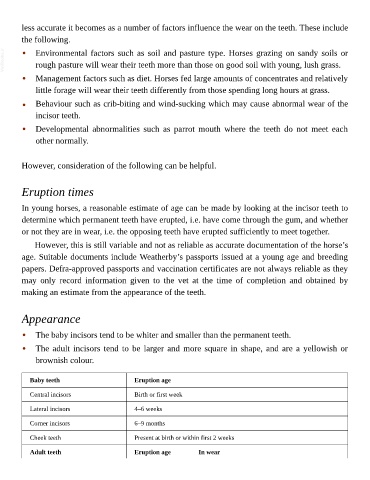Page 1063 - The Veterinary Care of the Horse
P. 1063
less accurate it becomes as a number of factors influence the wear on the teeth. These include
the following.
VetBooks.ir • Environmental factors such as soil and pasture type. Horses grazing on sandy soils or
rough pasture will wear their teeth more than those on good soil with young, lush grass.
• Management factors such as diet. Horses fed large amounts of concentrates and relatively
little forage will wear their teeth differently from those spending long hours at grass.
• Behaviour such as crib-biting and wind-sucking which may cause abnormal wear of the
incisor teeth.
• Developmental abnormalities such as parrot mouth where the teeth do not meet each
other normally.
However, consideration of the following can be helpful.
Eruption times
In young horses, a reasonable estimate of age can be made by looking at the incisor teeth to
determine which permanent teeth have erupted, i.e. have come through the gum, and whether
or not they are in wear, i.e. the opposing teeth have erupted sufficiently to meet together.
However, this is still variable and not as reliable as accurate documentation of the horse’s
age. Suitable documents include Weatherby’s passports issued at a young age and breeding
papers. Defra-approved passports and vaccination certificates are not always reliable as they
may only record information given to the vet at the time of completion and obtained by
making an estimate from the appearance of the teeth.
Appearance
• The baby incisors tend to be whiter and smaller than the permanent teeth.
• The adult incisors tend to be larger and more square in shape, and are a yellowish or
brownish colour.
Baby teeth Eruption age
Central incisors Birth or first week
Lateral incisors 4–6 weeks
Corner incisors 6–9 months
Cheek teeth Present at birth or within first 2 weeks
Adult teeth Eruption age In wear

